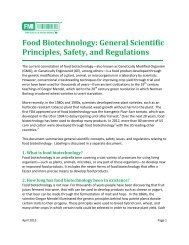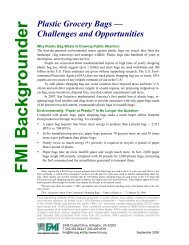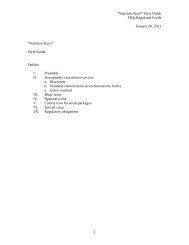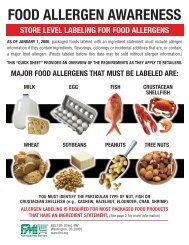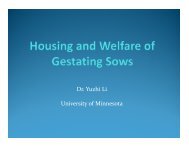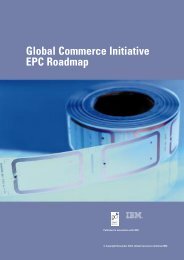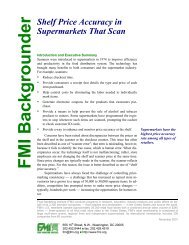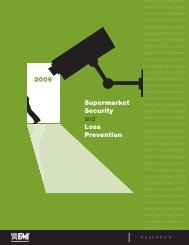Low-Level Use of Antibiotics In Livestock and Poultry
Low-Level Use of Antibiotics In Livestock and Poultry
Low-Level Use of Antibiotics In Livestock and Poultry
You also want an ePaper? Increase the reach of your titles
YUMPU automatically turns print PDFs into web optimized ePapers that Google loves.
<strong>Low</strong>-<strong>Level</strong> <strong>Use</strong> <strong>of</strong> <strong>Antibiotics</strong> in <strong>Livestock</strong> <strong>and</strong> <strong>Poultry</strong><br />
• Prevent disease among animals susceptible to infections. This use<br />
affects a larger number <strong>of</strong> animals, because it usually involves<br />
treating a whole herd or flock, which increases the likelihood <strong>of</strong><br />
genetic selecting for organisms that are resistant to the antibiotic.<br />
• Promote the growth <strong>of</strong> cattle, poultry <strong>and</strong> swine when they are fed low<br />
doses for long periods. As a growth-promoter, antibiotics in feed help<br />
animals gain weight more efficiently by controlling the bacteria that<br />
can interfere with their ability to absorb nutrients. Animals become<br />
healthier, grow faster <strong>and</strong> stronger, <strong>and</strong> fewer die from disease.<br />
2. Are drug residues in food the issue<br />
No. USDA routinely inspects meat, poultry <strong>and</strong> egg products for residues<br />
that exceed tolerance levels. The inspectors seldom find residues that<br />
exceed safe levels. The issue here involves antibiotic resistance <strong>of</strong><br />
bacteria, not antibiotic residues.<br />
It is also important to underst<strong>and</strong> that resistance has nothing to do<br />
with potency. The resistant bacteria are not stronger; they simply cannot<br />
be treated with antibiotics that are currently available.<br />
3. Why has antibiotic resistance increased in humans<br />
It is widely accepted that the primary cause is overuse <strong>and</strong> misuse <strong>of</strong><br />
antibiotics. <strong>In</strong> some cases, doctors prescribe or patients dem<strong>and</strong> the drugs<br />
too frequently or inappropriately, such as for illnesses that are not caused<br />
by bacteria <strong>and</strong> do not respond to antibiotics. <strong>In</strong> other cases, patients fail<br />
to complete the prescribed course <strong>of</strong> an antibiotic treatment, making it<br />
more likely that surviving bacteria will develop resistance to the drug.<br />
There is also evidence that antibiotic use in food-producing animals<br />
contributes to human drug resistance, although to a far lesser degree than<br />
human use does. The controversy centers over how significant this<br />
contribution is, how much <strong>of</strong> the problem stems from subtherapeutic use<br />
<strong>and</strong> how to respond.<br />
4. What triggered the controversy<br />
The issue emerged in 1984 when a CDC study linked antibiotics in<br />
livestock <strong>and</strong> poultry feed to resistant bacteria in humans. 2 The issue<br />
resurfaced in the 1990s with reports about the emergence <strong>of</strong> antibioticresistant<br />
strains <strong>of</strong> Salmonella, Campylobacter <strong>and</strong> E. coli O157:H7.<br />
CDC reported an increase in resistance in laboratory samples from 0.6<br />
percent in 1979 to 34 percent in 1996. 3 The study noted that a serotype <strong>of</strong><br />
Salmonella known as DT104 is resistant to five antibiotics <strong>and</strong> has<br />
become a major cause <strong>of</strong> illness in humans <strong>and</strong> animals in Europe,<br />
especially in the United Kingdom.<br />
A Minnesota study linked an increase in quinolone-resistant<br />
Campylobacter jejuni infections from 1992 through 1998 to the licensing<br />
As a growth promoter,<br />
antibiotics in feed help<br />
animals gain weight<br />
more efficiently by<br />
controlling the bacteria<br />
that can interfere with<br />
their ability to absorb<br />
nutrients.<br />
The issue here involves<br />
antibiotic resistance <strong>of</strong><br />
bacteria, not antibiotic<br />
residues.<br />
The issue emerged in<br />
1984 when a CDC study<br />
linked antibiotics in<br />
livestock <strong>and</strong> poultry<br />
feed to resistant bacteria<br />
in humans.<br />
2 “Drug-Resistant Salmonella From Animals Fed Antimicrobials,” New Engl<strong>and</strong><br />
Journal <strong>of</strong> Medicine, September 6, 1984.<br />
3 “Emergence <strong>of</strong> Multidrug-Resistant Salmonella enterica Serotype Typhimurium<br />
DT104 <strong>In</strong>fections in the United States,” New Engl<strong>and</strong> Journal <strong>of</strong> Medicine,<br />
May 7, 1998.<br />
Food Marketing <strong>In</strong>stitute 2




